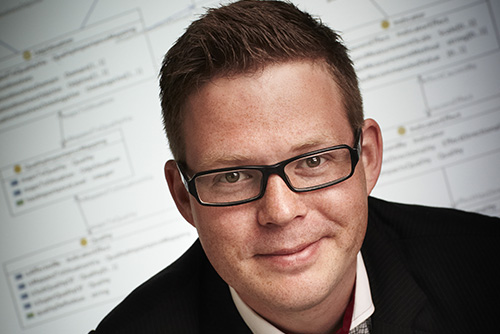Towards a future where machines understand us
In most respects, the web and its possibilities have evolved far beyond what most people thought was possible. In other respects, we have only just scratched the surface. In a new PhD thesis, Karl Hammar is finding models that can take the internet to the next step.

The web is primarily used for communication between people. Most of the content, whether text, image or video is incomprehensible for software and machines. A search engine can find information for you based on keywords, but you must still interpret and scan the search results yourself. However, if your phone or computer could understand a phone call you make, for example about your car having broken down, the software could find suitable service station near you, compare prices and reviews, book an appointment in your calendar and check which bus to take home. The vision of a future web where people and computers share information is called the Semantic Web.
For the Semantic Web to become a reality, people and computers need to agree and standardise communication at two different levels. The first level concerns the format and syntax of information exchange between computers or systems; there are already several established standards for transmitting content on this level, such as formats for texts, images etc. The second level concerns the definitions and semantics of things that systems and people should be able to communicate about, such as events and places. On this level, there is much work left to do and web developers in general lack both the required knowledge and appropriate tooling.
Karl Hammar has worked with these questions for many years. In his PhD dissertation, he has studied so-called ODPs, or Ontology Design Patterns. Ontology is the study of the nature of being, i.e., the concepts and relations in existence, and Design Patterns are recurring patterns in those things that need to be described. As an example, some attributes are shared by different types of events, whether the event is an accident, a concert or a trip; the event has extension in time, it has a geographical location, there are people who experience or report about the event, and so on. These are things that Karl Hammar has worked to define and structure in such a way that computers can understand them. An important aspect of this work involves finding the balance between what is effective for a computer to work with and reason over, and what is understandable to a human being.
This dissertation increases the knowledge of how ODPs can be constructed and described, how they are used best and how tools to handle them should work.
“The research group I'm a part of is building an infrastructure that enables the use of knowledge”, says Karl Hammar.
A standardised way of organising knowledge and information would also allow for different systems to communicate with each other. The purpose is to find models that will help software developers standardise information. One implementation is to add tags to a website that are not noticeable to people, but that can be seen and interpreted by software. Such tagging using shared definitions would for instance make it easier for a web browser or intelligent agent to compare prices and services across vendors, or to compare how different news sites report about a certain event.
Karl Hammar, who works at School of Engineering, Jönköping University, successfully defended his dissertation Content Ontology Design Patterns: Qualities, Methods, and Tools at Linköping University on 29 September.
